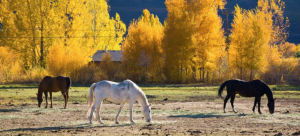Choosing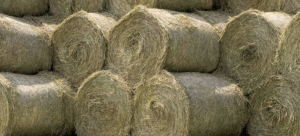 hay for your horse has much to do with his metabolism. Is your horse an easy keeper that requires few calories to stay in fighting weight? Or, is he a hard doer that demands calorie-laden meals to maintain reasonable body condition? Perhaps he is of moderate metabolism—if he’s fed normal fare in standard amounts, he’s good to go. What’s a horse owner to do when it comes to pairing metabolism with hay selection? Use these general tips to find a suitable hay for your horse.
hay for your horse has much to do with his metabolism. Is your horse an easy keeper that requires few calories to stay in fighting weight? Or, is he a hard doer that demands calorie-laden meals to maintain reasonable body condition? Perhaps he is of moderate metabolism—if he’s fed normal fare in standard amounts, he’s good to go. What’s a horse owner to do when it comes to pairing metabolism with hay selection? Use these general tips to find a suitable hay for your horse.
Easy keepers. These horses, genetically blessed to maintain weight easily, are perhaps the simplest for horse owners to nourish, especially when it comes to hay selection. While all hay intended for horses should be free of dust, mold, and weeds, owners of easy keepers should be on the lookout for fair- to good-quality grass hay.
“Forage will represent most, if not all, of an easy keeper’s diet, especially if the horse or pony is not in work, so choosing the right kind of hay is important,” explained Catherine Whitehouse, M.S., an equine nutrition advisor with Kentucky Equine Research (KER). “The key is to select hays that are predominantly grass, as these have fewer calories than legume hays, such as alfalfa or clover. Though perfectly acceptable, most easy keepers do not require the caloric punch of high-quality grass hay. Easy keepers generally do well on grass mixtures, maybe even late-maturing blends, which often have a little of this and a little of that.”
Though it might be tempting for owners of easy keepers to buy the best hay available, a balancing act is necessary, as both quality and quantity of hay should be considered. “If hay is all that an easy keeper has available to eat, it is important to keep the quality in check so that a sufficient quantity can be fed,” advised Whitehouse. “A hay that is appropriate for an easy keeper, such as mid- to late-maturing grass, might have only 80% of the calories of an early-maturity legume.”
From a practical standpoint, this means the same amount of calories would be found in 10 lb (4.5kg) of the grass hay or 8 lb (3.6kg) of the legume. With the importance of gastric motility in mind, it is far healthier for easy keepers to have access to near-constant source of low-calorie hay than smaller meals of high-calorie hay.
Horses and ponies with a known sensitivity to sugar, especially those that are prone to laminitis, should be given hay low in nonstructural carbohydrates (NSC), preferably near 10-12% of dry matter. A laboratory such as Equi-Analytical can test hay for NSC, and an equine nutritionist can formulate an appropriate diet based results from forage testing.
Horses fed all-forage diets may not consume all of the nutrients required for optimal health, even if they maintain body weight easily. Choose a well-formulated vitamin and mineral supplement to augment the forage. Try Micro-Max, a supplement formulated by KER that is especially appropriate for horses that may have insulin resistance or metabolic syndrome. In Australia, choose Nutrequin or Gold Pellet.
Horses with moderate metabolism. Owners of horses with moderate, or average, metabolism have much more leeway in the hays they choose. Healthy portions of good-quality grass hay, about 1.5-2% of body weight, coupled with an appropriate concentrate fed at the recommended levels will usually keep these horses in optimal weight.
“In choosing hay for these horses, owners have more freedom. They could seek out good-quality grasses or maybe some grass-legume mixes. At this point, availability might come into play. Since so many types of hay could satisfy nutritional requirements, it is easiest to choose one that’s readily available,” Whitehouse said.
Hard keepers. Choosing a suitable hay can significantly help achieve weight gain or maintenance in a hard keeper, according to Whitehouse.
“Legumes and legume mixes provide an edge for horses that have difficulty maintaining weight. Alfalfa and clover are the legumes most familiar to horse owners. The uptick in calories often associated with high-quality hay made from immature, and thus nutritiously ripe, plants can go a long way in meeting calorie demands,” she added.
Legumes should be especially leafy, as most of the nutrients are found in the leaves. Older horses often do well on legumes because they can easily process the soft leaves regardless of the condition of their teeth.
The question of quantity becomes a factor, too. For most horses, especially hard keepers, it is important to keep hay in front of them at all times. Not only are the digestive benefits irrefutable—a working, dynamic gastrointestinal tract is far healthier than a static one—but many horses will often resort to eating when bored, so it is best to keep haynets or feeders well stocked.
Some hard keepers are notoriously picky eaters. While most horses object to the concentrate portion of their rations, every now and then a horse comes along that finds alfalfa distasteful. “Though flat-out refusal of alfalfa is not common, it does happen,” said Whitehouse. “In these instances, it is best to source a good-quality grass hay that was baled at early maturity.”
Forage selection is integral in formulating a diet for horses and ponies, whatever their metabolism may be. Would you like help evaluating your horse’s diet? Contact us at J & J Farms by clicking here!
Article brought to you by KER.
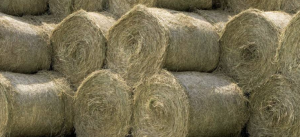

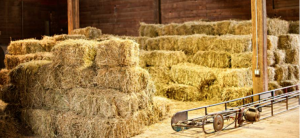 The color of horse hay is very useful in determining the quality of the hay. Methods of curing and storing hay greatly influence its appropriateness for horses.
The color of horse hay is very useful in determining the quality of the hay. Methods of curing and storing hay greatly influence its appropriateness for horses.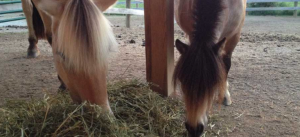 An age-old question: when is feeding old hay to horses O.K.?
An age-old question: when is feeding old hay to horses O.K.?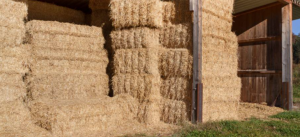 Cultivating good-quality hay is no easy task and is dependent on cooperative weather for optimal success. Hay farmers must keep a keen eye on plant growth, the moisture content at harvest, and other baling considerations in order to avoid moldy hay for horses. Mold forms on hay because of excessive moisture, which is why it is so critical to harvest hay under the most conducive conditions and then store it properly once baled.
Cultivating good-quality hay is no easy task and is dependent on cooperative weather for optimal success. Hay farmers must keep a keen eye on plant growth, the moisture content at harvest, and other baling considerations in order to avoid moldy hay for horses. Mold forms on hay because of excessive moisture, which is why it is so critical to harvest hay under the most conducive conditions and then store it properly once baled.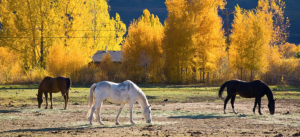 As autumn shifts to winter, or summer droughts begin to set in, horse owners in many climates must provide horses with an appropriate alternative forage to fulfill fiber requirements. In most cases, this involves switching to hay, haylage, or hay cubes.
As autumn shifts to winter, or summer droughts begin to set in, horse owners in many climates must provide horses with an appropriate alternative forage to fulfill fiber requirements. In most cases, this involves switching to hay, haylage, or hay cubes.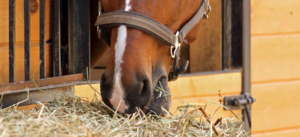 Common hays fed to horses include various pure grass hays, mixed grass hays, and legume hays such as alfalfa (lucerne) and clover. If these hays are not available, horse owners may have to choose alternative hays from less traditional hay types. While these other forages are usually suitable for horses, some have associated risks.
Common hays fed to horses include various pure grass hays, mixed grass hays, and legume hays such as alfalfa (lucerne) and clover. If these hays are not available, horse owners may have to choose alternative hays from less traditional hay types. While these other forages are usually suitable for horses, some have associated risks. hay for your horse has much to do with his metabolism. Is your horse an easy keeper that requires few calories to stay in fighting weight? Or, is he a hard doer that demands calorie-laden meals to maintain reasonable body condition? Perhaps he is of moderate metabolism—if he’s fed normal fare in standard amounts, he’s good to go. What’s a horse owner to do when it comes to pairing metabolism with hay selection? Use these general tips to find a suitable hay for your horse.
hay for your horse has much to do with his metabolism. Is your horse an easy keeper that requires few calories to stay in fighting weight? Or, is he a hard doer that demands calorie-laden meals to maintain reasonable body condition? Perhaps he is of moderate metabolism—if he’s fed normal fare in standard amounts, he’s good to go. What’s a horse owner to do when it comes to pairing metabolism with hay selection? Use these general tips to find a suitable hay for your horse.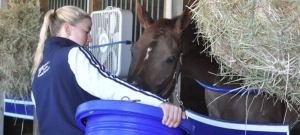
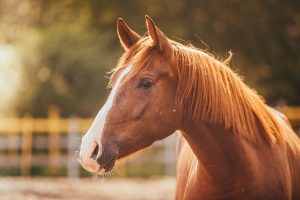 Horsemen recognize the importance of good-quality forage for horses and ponies. As such, horse owners are becoming savvier in choosing the best hay for their horses, especially when those horses are affected by metabolic conditions.
Horsemen recognize the importance of good-quality forage for horses and ponies. As such, horse owners are becoming savvier in choosing the best hay for their horses, especially when those horses are affected by metabolic conditions.